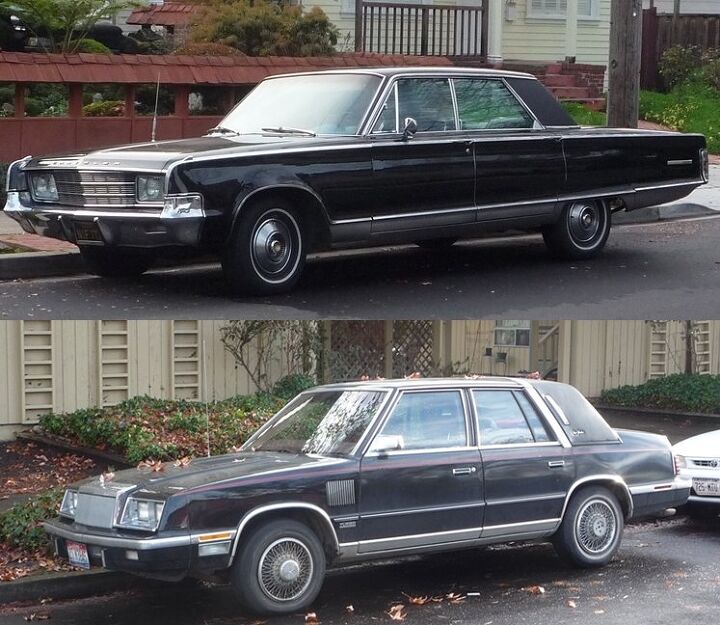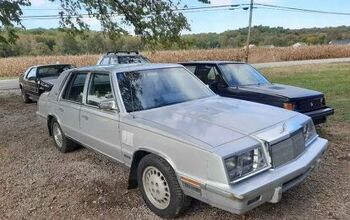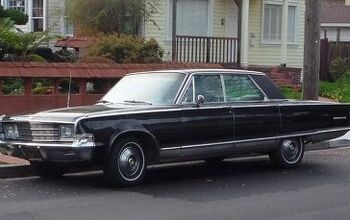Curbside Classic: 1985 Chrysler New Yorker

Let’s hold our nose and consider the decline and fall of the Chrysler New Yorker. Twenty years earlier, that name typified the grace, comfort, style and performance that New Yorkers had been know for since the first New Yorker ran off the lines in 1939. The energy crisis and the decline of the big car brought on a prolonged slide that should have ended with its retirement in 1982. But Lee Iaccoca would have none of that: the New Yorker would be reinKarnated! Add three inches to that infinitely malleable K-car platform, and slap on a healthy dollop of all the usual faux-luxury car trappings of the time, and presto: a mini-me New Yorker. Just in case you forgot what it looked like in its prime, here’s the before and after:
But don’t think just because you were getting a four-cylinder Reliant with a couple of hundred dollars worth of plasticky body add-ons bought in bulk from J C Whitney and a turbo conversion with all the subtlety and refinement of a home-brew job, that the new New Yorker was going to be a bargain. Inflation adjusted, both of these cars cost about the same: $27k in today’s dollars.
Chrysler hadn’t yet invented a V6 engine, so slapping a turbo on the 2.2 liter four was the only game in the big apple’s attempt to invoke luxury car performance. That is, if you were willing to shell out the extra bucks for it, because Lee had no compunction about the New Yorker having a 101 hp four as the standard engine. Your investment in turbo lag worthy of a stubborn mule yielded a magnificent 146 hp, once it spooled up. The little turbo four might have been some fun in the Omni GLH with a stick, but in the New Yorker teamed up with a three-speed automatic it was about as sporty as when the same combination was put to work powering a long-wheelbase Grand Caravan.
But once ensconced in that luxurious interior of fine Corinthian leather, all was well with the world. The instant response and torque of a healthy 413 V8 was now just a distant memory. Press on that go pedal, and eventually something happened, in herky jerky fashion. But it was all worth it, to save gas. Ironically, gas prices were already plummeting by the time the New Yorker hit the streets in 1983. But there was always the Fifth Avenue, a former Dodge Aspen also given the full Iacocca treatment. Its 318 V8 had less horsepower (140) but some vestige of low-end torque.
Some of the finer examples of what your $14k bought you in 1985: wire wheel covers, fake fender vents and a turbo badge. We’ll have to go to the next picture to show you the hood vents, the true mark of a refined luxury car.
There they are! The package is complete. Your New Yorker awaits you, sir!
I’ve been getting a bit tired of the endless “these all rusted out in three years” comments to Curbside Classics, and my inner Kraut is on the verge of going all Bertel and banning anyone who ever does that again :), but I’m going to postpone it for this car. So help yourself, and pile on with all the rusty comments you want, because it would make me happy to know that some parts of the country aren’t plagued with these things.

More by Paul Niedermeyer
Latest Car Reviews
Read moreLatest Product Reviews
Read moreRecent Comments
- SCE to AUX All that lift makes for an easy rollover of your $70k truck.
- SCE to AUX My son cross-shopped the RAV4 and Model Y, then bought the Y. To their surprise, they hated the RAV4.
- SCE to AUX I'm already driving the cheap EV (19 Ioniq EV).$30k MSRP in late 2018, $23k after subsidy at lease (no tax hassle)$549/year insurance$40 in electricity to drive 1000 miles/month66k miles, no range lossAffordable 16" tiresVirtually no maintenance expensesHyundai (for example) has dramatically cut prices on their EVs, so you can get a 361-mile Ioniq 6 in the high 30s right now.But ask me if I'd go to the Subaru brand if one was affordable, and the answer is no.
- David Murilee Martin, These Toyota Vans were absolute garbage. As the labor even basic service cost 400% as much as servicing a VW Vanagon or American minivan. A skilled Toyota tech would take about 2.5 hours just to change the air cleaner. Also they also broke often, as they overheated and warped the engine and boiled the automatic transmission...
- Marcr My wife and I mostly work from home (or use public transit), the kid is grown, and we no longer do road trips of more than 150 miles or so. Our one car mostly gets used for local errands and the occasional airport pickup. The first non-Tesla, non-Mini, non-Fiat, non-Kia/Hyundai, non-GM (I do have my biases) small fun-to-drive hatchback EV with 200+ mile range, instrument display behind the wheel where it belongs and actual knobs for oft-used functions for under $35K will get our money. What we really want is a proper 21st century equivalent of the original Honda Civic. The Volvo EX30 is close and may end up being the compromise choice.







































Comments
Join the conversation
I have a 1985 Chrysler New Yorker. has been doing ok till recently. Mechanic tells me it would cost more to fix then it is worth. Then I see a guy selling his for $6000. But it is all I have so if anyone can give me pointers that would be great.
Growing up, we always had multiple cars - at least 4, not including the van. My Dad always had to have a van and a sports car, and he's had some weird ones over the years. Not many people had ever heard of Saab's Sonett, but he had three of them; two which ran and one that needed work. But the first car I started to learn to drive was the 84 New Yorker he'd bought new (traded in an 83 Reliant K for it) and it was one of those talking cars, the door is ajar, etc. Anyway, it was a nice car; had the velour interior rather than leather, digital dash - I'm not sure if it was a turbo or not, but I don't think it was. Despite the low HP numbers it could get up - or at least it felt that way to a brand new permit-holder. Just seeing pics of the New Yorker brought back some good memories. Thanks for sharing.